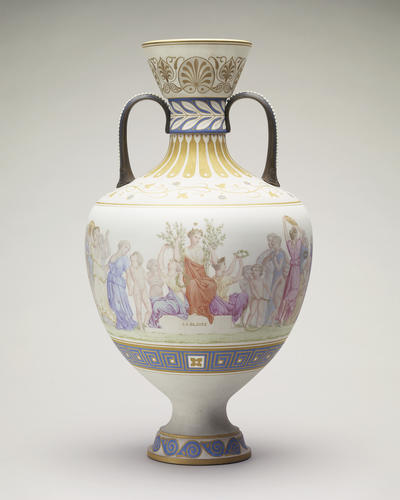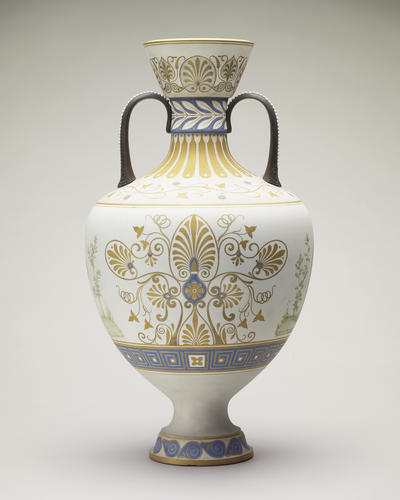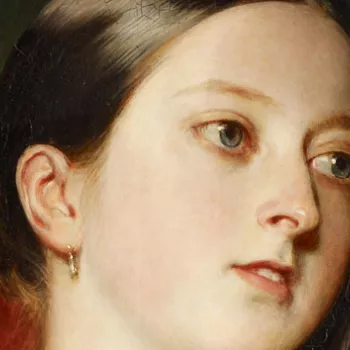La Gloire c.1850-51
Porcelain, glass | 62.8 cm (whole object) | RCIN 34032
-
A large white porcelain bulbous vase, the neck and foot with sgraffito decoration in gold and cobalt blue, the body painted with an enthroned figure surrounded by others; two gilt metal handles to the sides with enamel beading; on a base under glass.
At the Great Exhibition in London the Sèvres manufactory displayed the full range of its recent productions. From the exhibit, Queen Victoria purchased this vase and a tea service for herself, and a number of other items intended as gifts for Prince Albert: enamelled plaques (four after Charles Jalabert representing the Evangelists, and a Madonna after Raphael), and a pair of bronze-mounted vases with dancers after Raphael. The Prince bought himself a pair of biscuit vases.
The form of the vase (vase Etrusque de Naples) was devised in 1849 by the architect Henri Labrouste (1801-75), reproducing an ancient example from the Neapolitan royal collection in the Museo Borbonico at Naples. The factory records show that the Queen's vase was completed by 15 March 1851. The frieze, signed by Charles Barriat, with a central seated female figure (La Gloire), holding sprays of foliage and flanked by two attendants and other supporting figures, was based on a cartoon by Jean-Louis Hamon, a pupil of Delaroche who was employed by the factory at this time. His transparent tones, with bright colours for the foreground figures and grisaille for those behind, were thought especially suitable for neoclassical works of this kind.
In his monumental Industrial Arts of the nineteenth century, Digby Wyatt noted that while the form of the vase was well known, the application of colour and subject seemed ‘perfectly original’. ‘The skill with which [Hamon] has deviated from the antique just to a sufficient extent to attain freshness and a peculiar delicacy of effect without in any way losing the purity of the source whence his inspiration has been drawn reflects the highest credit upon him.’
The vase was one of a pair. The other, painted by Barriat, likewise from cartoons by Hamon, is in the Victoria and Albert Museum, London. It was purchased from Sèvres by a committee comprising Henry Cole, Richard Redgrave, J.R. Herbert, Owen Jones and A.W.N. Pugin, charged with acquiring outstanding works from the Exhibition for the Marlborough House Museum.
Text from Victoria & Albert: Art & Love.Provenance
Purchased by Queen Victoria on 17 December 1851 for 1 800 francs and presented to Prince Albert on her birthday, 24 May 1851. One of a pair of vases shown at the Great Exhibition. The pair is in the V&A collection, catalogue number 452-1852.
-
Creator(s)
(porcelain manufacturer)(nationality) -
Medium and techniques
Porcelain, glass
Measurements
62.8 cm (whole object)
Category
Object type(s)
Place of Production
Sèvres [France]










